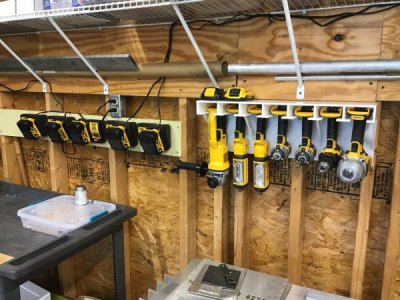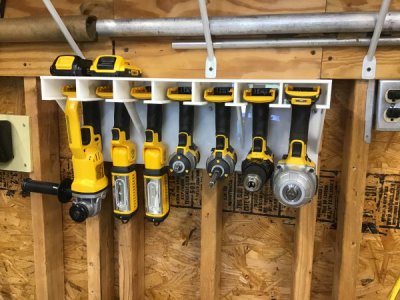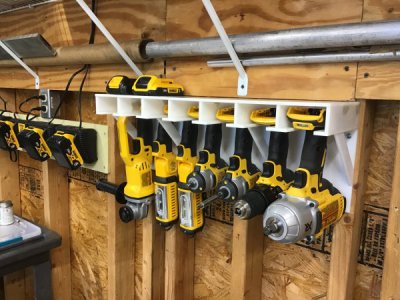I love it! Did you start with acrylic sheet or was it some kind of channel? Is that just glued up?
Robert
Thanks, Robert.
I started with 1/4" cast acrylic sheet and glued it up. I had very good success on a previous project and had quite a bit left over, so I thought I'd give this a shot. The back piece is 8" tall; the top is 6" deep (easily big enough for spare batteries or even chargers), and the spacers are 2"-ish (just enough to allow for an easy slide of the tool bases) spaced 3" apart. The slot openings themselves are 1 5/8" - 1 3/4" (don't remember which I settled on). The whole rack is just under 22". The most challenging piece was the slotted support running under the tools. You can't tell from the photos, but that piece, which holds all seven tools, is a single unit - joined together at the back by 1/2" of stock. I originally thought to make individual pieces glued up separately, but I realized I could almost as easily mill it as a single unit. The only complication was that due to the shape, I couldn't use my 6" vise. I set up a fence on the mill table and took measurements for one slot - beginning to end. At the end, I reset my DRO to zero and did the next, etc., etc. The serpentine shape made it a much simpler matter to glue up - and it's sturdier. The gussets are essentially eyeballed. The front edge is 6" - give or take, but they're all identical. I milled a 45 on one side of each, then clamped all four together and milled the other 45; re-clamped all four uniformly in my vise and finished the 6" side; flipped it and did the same on the other side. I learned from RJSakowski that the bonding agent is not really a 'glue' in the traditional sense. It actually has a chemical reaction with the acrylic and acts more as a 'weld' than a glue. Based on my other projects, it seems to be an amazingly strong bond. As a side note, if you plan on building something similar, keep in mind that 1/4" cast acrylic is not necessarily exactly 0.250". I'm not sure if this is correct in all cases, but the high quality product I used is actually labeled 0.220" - even though it's advertised as 1/4". When you have eight pieces in the equation, the cumulative error can be significant. This is my only experience with buying cast acrylic, so measurements may vary among manufacturers.
This was actually a pretty fun and easy project. I'm sure most of us routinely deal with the issue of not having enough space to keep all our toys, er, tools, and if there's a square inch of wall space available, it makes sense to utilize it.
Regards,
Terry








